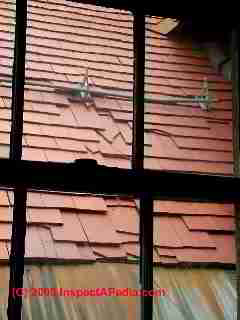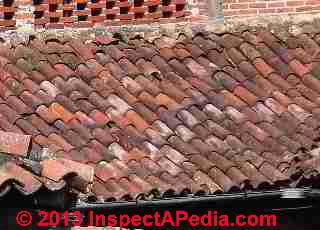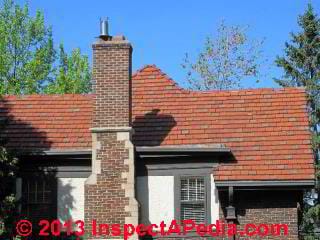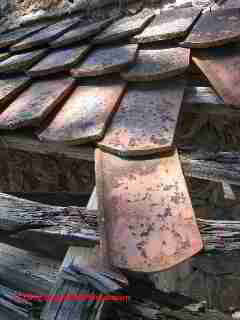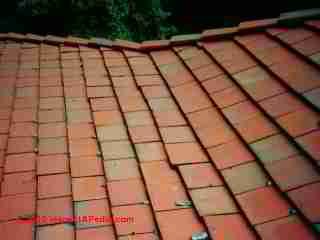 Clay Tile Roof Inspection Wear or Damage Indicators
Clay Tile Roof Inspection Wear or Damage Indicators
Photo Guide
to Clay Tile Roof Damage
- POST a QUESTION or COMMENT about wear & damage to clay tile roofs: spalling, pitting, cracking, breaking, loose, or missing clay tiles
Clay tile roof wear & damage:
In photographs & text this article describes & explains the causes of all types of wear and damage that can be found on clay tile roofs by visual inspection. These include roofing tiles that are cracked, broken, pitting, spalled, loose, or missing, and of course, leaks in a clay tile roof.
This article series explains clay tile roofing types, clay roofing tile inspection, tile roofing diagnosis, & tile roof repair.
InspectAPedia tolerates no conflicts of interest. We have no relationship with advertisers, products, or services discussed at this website.
- Daniel Friedman, Publisher/Editor/Author - See WHO ARE WE?
Examples of Clay Tile Roof Wear or Installation Problems that Limit Roof Life
In discussing types of clay tile roof damage, we include advice about how to inspect a tile roof and on how, if ever, you might walk on a clay tile or concrete tile roof.
[Click any image for an enlarged, detailed version.]
Our page top photo shows clay roofing tiles installed in the Northeastern U.S. This roof had been damaged by foot traffic. Clay tile roofs are often damaged by foot traffic, ice and snow, or by severe storms.
Our photo (left) shows the author (DF, back to camera) examining a clay tile roof installed on the Hwang Lim Won orphanage in Seoul, Korea in 1966.
The roof was constructed using an S-tile profile and was not leaking.
Tiles on the structure had to withstand Korean monsoon weather of heavy rain and high winds.
Our photo of a tarred roof valley and damaged interlocking clay roof tiles below was taken from a ladder at roof edge.
And below right, on a barn on the Roosevelt Estate in Hyde Park NY, ice and storm damage have broken many of these rectangular flat roof tiles.
[Click to enlarge any image]
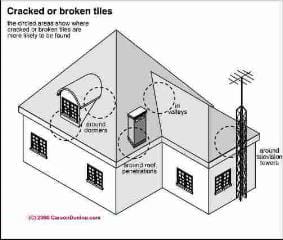
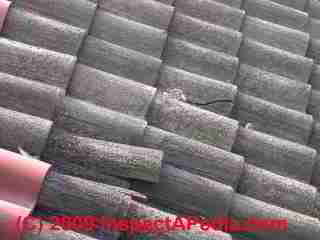
The common failures on clay tile roofs include cracked broken tiles, spalling (in freezing climates), loose tiles that slide down out of place (on roofs where not every tile is secured to the roof deck), flashing failures (corrosion or cracking), and fastener failures.
We also find leaks in clay tile roofs that were improperly flashed or that were built on a low slope and without a waterproof membrane.
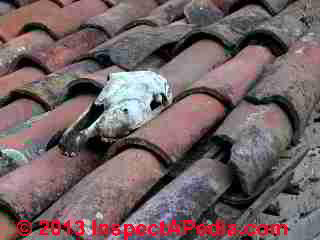 Our photo of broken clay roof shingle-tiles (above right) was taken during an inspection made without walking on the roof surface - for obvious reasons: we didn't want to shoulder the blame for this damage.
Our photo of broken clay roof shingle-tiles (above right) was taken during an inspection made without walking on the roof surface - for obvious reasons: we didn't want to shoulder the blame for this damage.
The clay tile roof shown at left, located near Xotolar, Guanajuato, Mexico, is more than 40 years old and shows only minor damage.
We recommend against walking on clay tile roofs as you are likely to damage the roof leading to the need for costly repairs. More discussion on walking on fragile roofs is later in this article.
Our photo (above left) shows broken clay roof tiles, a very common clay tile roof defect that is also a common leak source.
At the photo lower left corner you can see a pair of replacement clay tiles that have been put in place, but more replacements are needed wherever a broken roof tile is found. Carson Dunlop Associates' sketch (above right) illustrates the most common locations where cracked or broken tiles are found on clay tile roofs.
In some climates clay tiles may also become damaged by spalling from freezing when the tiles were wet.
Foot Traffic Advice: Walking on Clay Tile Roofs
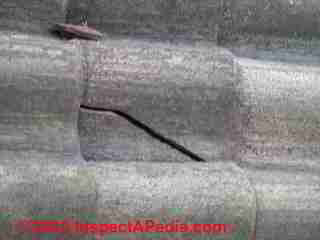
As we discuss at FLASHING, CLAY TILE ROOFS, and as stated in stated in Best Practices Guide to Residential Construction (Steve Bliss, J Wiley & Sons) (printed text), to prevent breakage, walk on tiles with extreme caution.
Profile tile and lightweight tile are the most vulnerable, and concrete tiles are more fragile when they are freshly manufactured or “green.”
If possible, place antennas and other roof-mounted equipment where it is easy to access without crossing many tiles.
Roof access hazards are discussed
at ROOF INSPECTION SAFETY & LIMITS
When it is necessary to walk on tiles, some authorities suggeest that you step only on the head-lap (lower 3 inches) of each tile.
With Mission- or S-tiles, it is best to step across two tiles at once to distribute the weight. When significant rooftop work is required, place plywood over the tile to distribute the load.
Removal of Roof Tiles May Be Necessary for On-Roof Access
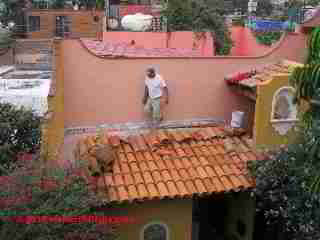
Watch out: our own experience is that it is absolutely impossible to walk on many clay tile roofs without damaging them, particularly soft clay such as the roof type used in Latin America (our photo at left).
For these roofs contractors have to remove sufficient clay tiles to provide a walking area.
The removed tiles are replaced as the worker is leaving the work area of the roof.
On some other fragile but not totally fragile roofs such as slate roofs, cement tile, cement-asbestos, fiber cement, and hard-fired ceramic clay tile roofs, contractors suspend a ladder over the roof surface, hanging it from the ridge, and cushioning it off of the roof surface using foam or insulation padding, or contractors work from scaffolding. - Ed.
White Stains on Clay Tile Roofs
White stains on tile roofs are typically an efflorescence deposit and may indicate that the tile is absorbing water, thus nearing end of life. But the extent of efflorescence and its significance in clay tile roofing varies quite a bit depending on the type of roofing tile (its degree of vitrification), climate, and other features.
Generally where we have seen white effloresence staining on clay tile roofs (such as the Mexican clay tile roof photographed below left ) I have not seen a notable correlation with remaining clay tile roof life.
The amount of water absorption into clay roofing tiles depends on the extent of clay vitrification, in turn an effect of how the clay tiles were fired or produced. Soft low-vitrification clay tiles such as those shown at above left (Mexico) are more likely to absorb water and would not perform well in freezing climates.
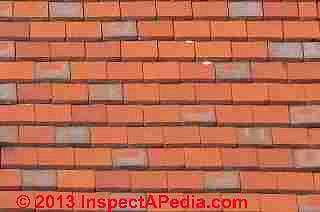 More often we see dark stains on these clay tile roofs, typically an algae formation. Generally low-vitrified soft clay tile roofs fail due to the fragility of the roofing tiles themselves, not from water absorption and mineral salt formation.
More often we see dark stains on these clay tile roofs, typically an algae formation. Generally low-vitrified soft clay tile roofs fail due to the fragility of the roofing tiles themselves, not from water absorption and mineral salt formation.
[Click any image for an enlarged, detailed version]
Our second clay tile roof (above right and in close-up at left), also showing some white effloresence stains on some tiles, is located in Duluth Minnesota. This roof is on an older home, is performing well in a very cold climate. This roof is almost certainly using a highly-vitrified clay roofing tile.
Other clay tile roofs I observed in Duluth and similar roofs I inspected in Oslo and Molde, Norway, used a vitrified flat clay tile that was also coated with a hard glaze. No white effloresence staining is found in these roofs.
Clay tile roofs are more likely to fail due to the fragility of the roofing tiles themselves, not from water absorption and mineral salt formation.
Hidden Structural Damage Below Clay Roofing Tiles
Here we illustrate another reason to stay off of clay tile roofs - very fragile, loose clay tiles and rotted collapsing structure below.
Walking on the roof we show at left is almost certainly going to break tiles and risk injury as the supporting structure may break below the inspector.
This particular roof condition could also be observed from inside the home's attic.
...
Reader Comments, Questions & Answers About The Article Above
Below you will find questions and answers previously posted on this page at its page bottom reader comment box.
Reader Q&A - also see RECOMMENDED ARTICLES & FAQs
On 2020-06-14 - by (mod) -
Daryl
Some clay products may use natural or other fibers such as fiberglass to add strength. Some of those high-strength clay tiles use a proprietary formula, so it can be tricky finding out the exact composition.
On 2020-06-13 by Daryl
Why do my clay tiles have fibers inside ?
On 2017-04-19 - by (mod) -
Nice question, Peter.
I don't like my answer but here it comes anyhow:
1. There is probably no really good "remedy" done to the spalled clay roof tiles themselves, as in my experience coatings and patches are ugly and not durable. More likely the tiles should be left alone unless they're worn so thin as to be unreliable or if they are actually broken or perforated.
2. At that point the bad tiles need to be replaced. If they involve more than 25% of the roof area, that job is so expensive some roofers will suggest wholesale replacement.
3. Let's diagnose the cause of the problem: are these old, defective individual tiles, or is there frost or ice damage, or has someone put salt on the roof to try to get rid of an ice problem? Are the tiles hard fired or soft? Are the roof tiles glazed or not? If not glazed, they're more vulnerable. If glazed they may be defective.
4. Does the damage appear on all roof slopes regardless of orientation?
Use the page top or bottom CONTACT link to send me some sharp photos if you can and I can comment further. Also tell me the location and age of the building.
On 2017-04-19 by Peter Buckley
What is the remedy for spalling of clay roof tiles and what is the cause
Question: black stains on clay roof
(Feb 20, 2013) Vinehoward@gmail.com said:
Purchasing a home and the Clay roof is blackened all over with what might be mold, or is it deterioration of the clay tile itself. Can it be cleaned and restored, and is a sealant needed to prevent future black staining?
Reply:
Howard, typically the black stains on clay roof tiles are a species of algae. For diagnosis, remedy, and prevention of black stains on roofs see these articles:
...
Continue reading at CLAY TILE ROOF FLASHING LEAKS or select a topic from the closely-related articles below, or see the complete ARTICLE INDEX.
Or see these
Recommended Articles
- CLAY TILE ROOFING - home
- CLAY TILE ROOF BATTENS & STACKING
- CLAY TILE ROOF CONNECTIONS
- CLAY TILE ROOF DAMAGE & WEAR
- CLAY TILE EAVES, HIP & RAKE DETAILS
- CLAY TILE ROOF FLASHING
- CLAY TILE ROOF FLASHING LEAKS
- CLAY TILE ROOF SLOPE, DECK & UNDERLAY
- CLAY TILE ROOF SPECIFICATIONS
- CLAY TILE ROOF SUPPLIERS
- CLAY TILE ROOF STYLES, DESIGNS
- CLAY TILE ROOFING
- CLAY TILE WIND & SEISMIC CONNECTORS
- CLAY, CONCRETE, FIBER CEMENT ROOF TILE CHOICES
- EFFLORESCENCE: WHITE DEPOSITS on ROOFS
Suggested citation for this web page
CLAY TILE ROOF DAMAGE & WEAR at InspectApedia.com - online encyclopedia of building & environmental inspection, testing, diagnosis, repair, & problem prevention advice.
Or see this
INDEX to RELATED ARTICLES: ARTICLE INDEX to BUILDING ROOFING
Or use the SEARCH BOX found below to Ask a Question or Search InspectApedia
Ask a Question or Search InspectApedia
Try the search box just below, or if you prefer, post a question or comment in the Comments box below and we will respond promptly.
Search the InspectApedia website
Note: appearance of your Comment below may be delayed: if your comment contains an image, photograph, web link, or text that looks to the software as if it might be a web link, your posting will appear after it has been approved by a moderator. Apologies for the delay.
Only one image can be added per comment but you can post as many comments, and therefore images, as you like.
You will not receive a notification when a response to your question has been posted.
Please bookmark this page to make it easy for you to check back for our response.
IF above you see "Comment Form is loading comments..." then COMMENT BOX - countable.ca / bawkbox.com IS NOT WORKING.
In any case you are welcome to send an email directly to us at InspectApedia.com at editor@inspectApedia.com
We'll reply to you directly. Please help us help you by noting, in your email, the URL of the InspectApedia page where you wanted to comment.
Citations & References
In addition to any citations in the article above, a full list is available on request.
- Mark Cramer Inspection Services Mark Cramer, Tampa Florida, Mr. Cramer is a past president of ASHI, the American Society of Home Inspectors and is a Florida home inspector and home inspection educator. Mr. Cramer serves on the ASHI Home Inspection Standards. Contact Mark Cramer at: 727-595-4211 mark@BestTampaInspector.com
- John Cranor [Website: /www.house-whisperer.com ] is an ASHI member and a home inspector (The House Whisperer) is located in Glen Allen, VA 23060. He is also a contributor to InspectApedia.com in several technical areas such as plumbing and appliances (dryer vents). Contact Mr. Cranor at 804-873-8534 or by Email: johncranor@verizon.net
- Tile Roofs of Alfred: A Clay Tradition in Alfred NY
- Roof Tiling & Slating, a Practical Guide, Kevin Taylor, Crowood Press (2008), ISBN 978-1847970237,
If you have never fixed a roof tile or slate before but have wondered how to go about repairing or replacing them, then this is the book for you. Many of the technical books about roof tiling and slating are rather vague and conveniently ignore some of the trickier problems and how they can be resolved. In Roof Tiling and Slating, the author rejects this cautious approach. Kevin Taylor uses both his extensive knowledge of the trade and his ability to explain the subject in easily understandable terms, to demonstrate how to carry out the work safely to a high standard, using tried and tested methods.
This clay roof tile guide considers the various types of tiles, slates, and roofing materials on the market as well as their uses, how to estimate the required quantities, and where to buy them. It also discusses how to check and assess a roof and how to identify and rectify problems; describes how to efficiently "set out" roofs from small, simple jobs to larger and more complicated projects, thus making the work quicker, simpler, and neater; examines the correct and the incorrect ways of installing background materials such as underlay, battens, and valley liners; explains how to install interlocking tiles, plain tiles, and artificial and natural slates; covers both modern and traditional methods and skills, including cutting materials by hand without the assistance of power tools; and provides invaluable guidance on repairs and maintenance issues, and highlights common mistakes and how they can be avoided. The author, Kevin Taylor, works for the National Federation of Roofing Contractors as a technical manager presenting technical advice and providing education and training for young roofers. - The Carson Dunlop home study course for home inspectors can be examined at the company's website at https://www.carsondunlop.com/training/us/
- Best Practices Guide to Residential Construction, by Steven Bliss. John Wiley & Sons, 2006. ISBN-10: 0471648361, ISBN-13: 978-0471648369, Hardcover: 320 pages, available from Amazon.com and also Wiley.com. See our book review of this publication.
- Building Pathology, Deterioration, Diagnostics, and Intervention, Samuel Y. Harris, P.E., AIA, Esq., ISBN 0-471-33172-4, John Wiley & Sons, 2001 [General building science-DF] ISBN-10: 0471331724 ISBN-13: 978-0471331728
- Building Pathology: Principles and Practice, David Watt, Wiley-Blackwell; 2 edition (March 7, 2008) ISBN-10: 1405161035 ISBN-13: 978-1405161039
- Problems in Roofing Design, B. Harrison McCampbell, Butterworth Heineman, 1991 ISBN 0-7506-9162-X (available used)
- In addition to citations & references found in this article, see the research citations given at the end of the related articles found at our suggested
CONTINUE READING or RECOMMENDED ARTICLES.
- Carson, Dunlop & Associates Ltd., 120 Carlton Street Suite 407, Toronto ON M5A 4K2. Tel: (416) 964-9415 1-800-268-7070 Email: info@carsondunlop.com. Alan Carson is a past president of ASHI, the American Society of Home Inspectors.
Thanks to Alan Carson and Bob Dunlop, for permission for InspectAPedia to use text excerpts from The HOME REFERENCE BOOK - the Encyclopedia of Homes and to use illustrations from The ILLUSTRATED HOME .
Carson Dunlop Associates provides extensive home inspection education and report writing material. In gratitude we provide links to tsome Carson Dunlop Associates products and services.




